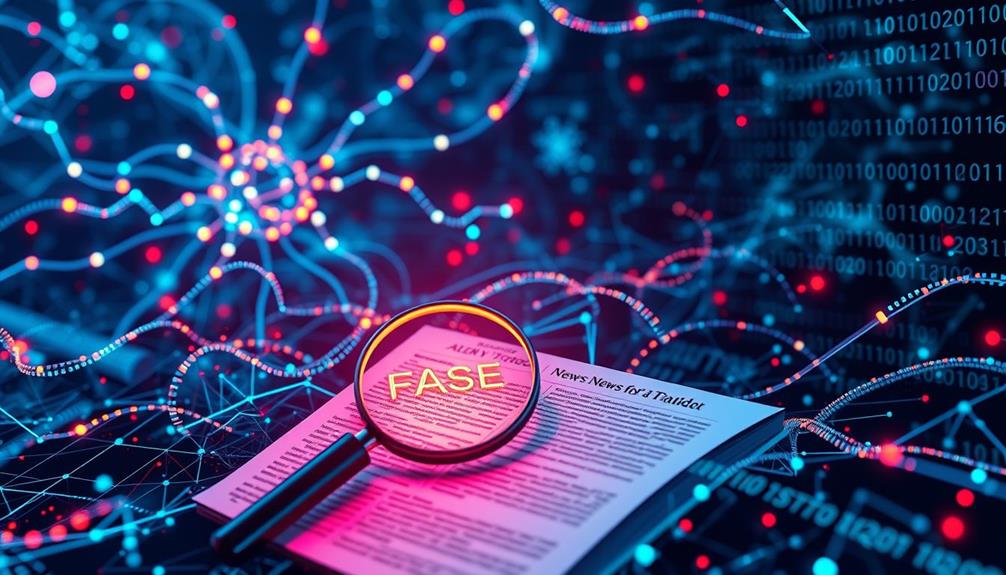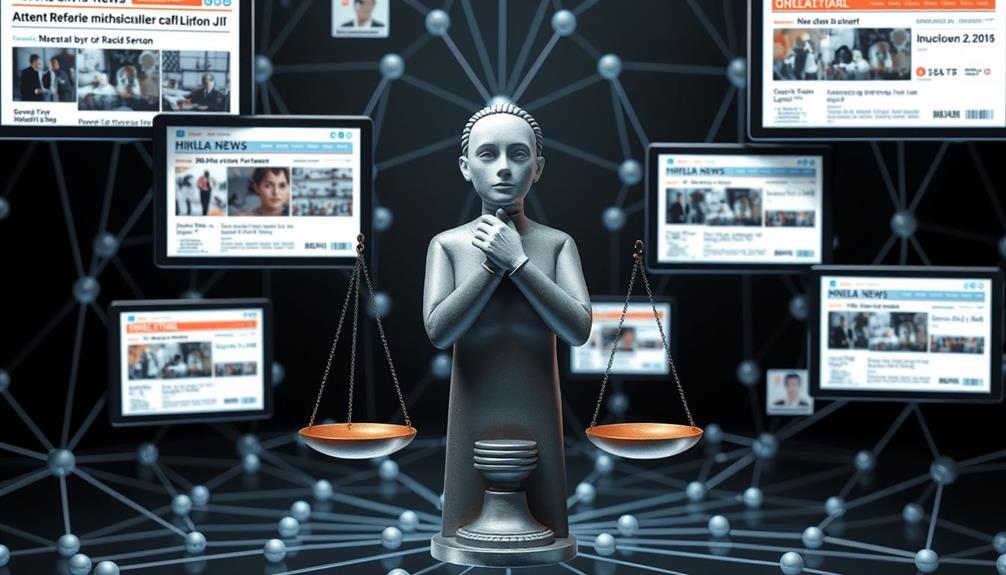AI plays an essential role in tackling fake news and misinformation, helping you sift through vast amounts of content. It uses advanced techniques like machine learning and natural language processing to detect misleading information swiftly. By analyzing patterns and real-time data, AI can flag suspicious content, improving your ability to trust what you see online. Collaboration with fact-checking organizations enhances its effectiveness and builds reliability. However, ethical considerations and transparency in AI algorithms are fundamental for maintaining public trust. For a deeper understanding of these AI strategies and their impact, there's much more to discover.
Key Takeaways
- AI techniques like LSTM and natural language processing analyze text patterns to detect and flag fake news in real-time.
- Hybrid models combining multiple algorithms improve detection accuracy and reduce false positives in misinformation identification.
- Ethical considerations, including transparency and bias mitigation, are crucial for building trust in AI-driven misinformation detection systems.
- Collaboration with fact-checking organizations enhances the reliability of AI systems in combating fake news and misinformation.
- Media literacy education programs empower individuals to critically evaluate information sources and recognize misleading content effectively.
The Impact of Fake News
The impact of fake news is profound and far-reaching, affecting individuals and society as a whole. When you encounter misleading information on social media, it can create confusion and breed mistrust. This is particularly important in understanding how narcissistic behaviors can manipulate perceptions and contribute to the spread of misinformation.
Historical examples, like the misinformation during the Ebola outbreak, show how fake news can lead to public panic and sensationalized coverage. You might remember how political misinformation, such as the rumors about death taxes during Australia's 2019 federal election, influenced voter behavior and swayed election outcomes.
A study found that over 50% of Taiwanese voters acted based on incorrect information, highlighting how misinformation can undermine democratic processes. As you scroll through your social media feeds, consider how algorithms often prioritize sensational content over factual news, contributing to a growing distrust in legitimate news sources.
This environment makes it easier for foreign misinformation campaigns—like those from entities such as China—to manipulate public opinion and exploit political divisions in countries like Taiwan. All these factors illustrate that the consequences of fake news extend beyond individual beliefs, affecting the fabric of society and the integrity of democratic institutions.
AI Techniques for Detection

Utilizing advanced AI techniques, researchers are making notable strides in detecting fake news. By leveraging memory-based methods like Long Short-Term Memory (LSTM) and Bidirectional LSTM (Bi-LSTM) models, they analyze text patterns to distinguish between authentic and misleading content. These models excel at understanding the context and semantics of language, thanks to the power of Natural Language Processing (NLP).
Furthermore, the rapid growth of AI raises concerns about AI's rapid growth and the ethical implications surrounding its use in combating misinformation.
Additionally, ensemble learning approaches are enhancing fake news detection by combining multiple algorithms, leading to improved accuracy over traditional methods. This collaborative approach helps minimize the high false positive rates that many existing models face.
However, as the tactics used to spread misinformation become increasingly sophisticated, the evolution of AI detection techniques is vital. Ongoing research is essential to address the shortcomings of current models, especially their struggles with context.
To tackle these challenges, hybrid models that integrate various AI techniques show promise for delivering better accuracy in fake news detection. By staying ahead of emerging challenges, AI can considerably contribute to the fight against misinformation and uphold the integrity of information in our digital world.
Ethical Considerations in AI

When you think about AI in combating fake news, consider the transparency of algorithms and how it affects public trust.
It's also essential to address any biases that might skew the information being shared, as this can lead to conflicts of interest and misinformation.
Balancing these ethical considerations is key to ensuring AI serves the public good.
Transparency in Algorithms
Although many people rely on AI systems for accurate information, transparency in algorithms is essential to build trust and guarantee accountability. When algorithms operate behind a veil of secrecy, skepticism arises regarding the reliability of the information they provide.
Ethical AI deployment hinges on understanding how algorithms prioritize certain content, which helps mitigate biases that could skew your interpretation of data. Additionally, adopting practices such as keyword and topic clustering can enhance the relevance of the information being presented, making it easier for users to find accurate content.
Regulatory frameworks advocating for algorithmic transparency can enhance accountability for tech companies. By encouraging them to disclose the criteria used for content moderation and ranking, users gain insight into how information is curated.
Studies show that when algorithms are transparent, public perception of AI-driven content curation improves. You'll likely find that you trust systems more when you can scrutinize and understand their operations.
This emphasis on transparency aligns with broader ethical considerations, promoting informed user engagement. With clearer insights into how algorithms function, you're empowered to assess the reliability of information sources effectively.
Ultimately, fostering transparency in algorithms isn't just about accountability; it's about ensuring that you, as a user, can navigate the complex landscape of information with confidence.
Addressing Biases Effectively
AI's potential to combat fake news is considerably hampered by inherent biases that can distort information detection and dissemination. These biases can lead to unfair treatment of certain groups, especially in misinformation detection processes. For instance, biased algorithms might produce higher false positive rates for content linked to marginalized communities, eroding trust in AI technologies.
To effectively address these biases, it's essential to use diverse and representative training datasets. This guarantees that models can generalize well across various demographics. Transparency in algorithmic decision-making processes is critical, as it helps build user trust and allows identification of biased outcomes.
Here's a summary of key considerations:
| Bias Factor | Impact on Misinformation Detection |
|---|---|
| Training Data Quality | Poor data leads to skewed detection results |
| Algorithm Transparency | Lack of clarity fosters mistrust |
| Community Representation | Marginalized voices may be misrepresented |
| Continuous Monitoring | Ongoing assessment is necessary for fairness |
| Ethical Collaboration | Tech, ethicists, and communities must unite |
Conflicts of Interest
Numerous conflicts of interest can arise in the deployment of AI, particularly when companies prioritize profit over ethical considerations. When profit takes precedence, algorithms can become biased, inadvertently perpetuating misinformation rather than combating it. This undermines the very purpose of AI in addressing fake news. The risks associated with email and communication security highlight the necessity for ethical guidelines in AI to guarantee that information dissemination remains accurate and trustworthy.
To tackle these conflicts, transparency in AI algorithms is vital. You need to understand how information is curated and moderated, as this insight can reveal potential biases and commercial motives.
Ethical guidelines must be established to navigate the implications of AI-driven content moderation, especially when tech companies manipulate information for economic gain. Such actions can distort public opinion and discourse, leading to adverse societal outcomes.
Involving stakeholders, including governments and civil society, is essential for holding AI developers accountable. This collective effort can prevent conflicts of interest that threaten democratic processes.
Addressing these issues requires a firm commitment to ethical data governance and the creation of standards that prioritize truthfulness and user trust. By demanding accountability, you can help guarantee that AI serves as a tool for enhancing information integrity, rather than as a means to profit at the expense of accuracy.
Collaborative Strategies Against Misinformation

To effectively combat misinformation, you need to understand the importance of collaboration among various stakeholders.
Establishing a network of credible voices can enhance social proof in promoting accurate information and countering false narratives.
Initiatives that promote media literacy and ethical AI practices play an essential role in this fight.
Stakeholder Collaboration Initiatives
Combatting misinformation requires robust collaboration among various stakeholders in today's digital landscape. Initiatives like the Global Coalition for Digital Safety bring together tech companies, public officials, and civil society to enhance media literacy and combat misinformation collectively.
These stakeholder collaboration initiatives focus on sharing best practices and resources, improving fact-checking, content moderation, and identifying false information across multiple platforms. Additionally, just as understanding vegan status of common foods is essential for making informed dietary choices, public education on recognizing misinformation is important for steering through digital content effectively.
Moreover, the AI Governance Alliance plays an important role by promoting responsible AI development. It facilitates cooperation among industry leaders, governments, and academia to address the challenges posed by misinformation. These partnerships are significant for creating advanced AI tools that can effectively detect and mitigate the spread of fake news.
Through these collaborative efforts, stakeholders emphasize the importance of public education on media literacy. Empowering individuals to critically assess information helps them recognize misinformation independently, making the digital space safer for everyone.
Media Literacy Education Programs
In the fight against misinformation, media literacy education programs play an essential role by empowering you to critically assess information sources. By participating in these programs, you learn to distinguish between credible news and misinformation, enhancing your resilience against fake news. Collaborative strategies in media literacy often involve partnerships among educational institutions, tech companies, and civil society, creating thorough curricula focused on evaluating digital content.
Here's a snapshot of the impact of media literacy education:
| Key Focus | Benefits | Outcomes |
|---|---|---|
| Critical Thinking | Enhanced analysis skills | Better recognition of misleading info |
| Ethical Implications | Understanding consequences | More responsible sharing of information |
| Community Engagement | Improved retention of skills | Stronger detection of misinformation |
| Interactive Learning | Increased motivation | Greater participant involvement |
| Collaboration | Diverse perspectives | Holistic curriculum development |
Research shows that those who engage in media literacy programs are more likely to reject misleading information, demonstrating a measurable increase in critical thinking skills. These programs foster an understanding of the ethical implications of sharing information, encouraging responsible online behavior.
Ethical AI Deployment Practices
Media literacy education lays a strong foundation for understanding the role of technology in fighting misinformation, but it's also vital to implement ethical AI deployment practices.
These practices help guarantee that AI detection algorithms are transparent, accountable, and effective against misinformation challenges. By fostering collaboration among tech companies, journalists, and civil society, we can create a more robust approach to combatting disinformation.
Additionally, leveraging AI-driven threat intelligence can enhance our ability to respond to emerging misinformation trends in real-time. Moreover, the integration of machine learning models can help adapt to evolving misinformation tactics.
Here are some key strategies to reflect on:
- Build regulatory frameworks that guide ethical AI deployment, ensuring compliance with standards.
- Encourage partnerships between industry leaders, governments, and academia to share best practices.
- Incorporate user feedback into AI detection algorithms, enhancing their accuracy and responsiveness.
- Promote public education initiatives that raise awareness about misinformation and its effects.
- Establish real-time monitoring systems that can quickly adapt to emerging misinformation trends.
These collaborative strategies not only strengthen the fight against fake news but also build public trust in the technologies designed to protect us.
Regulatory Frameworks for Digital Safety

Regulatory frameworks for digital safety are essential in traversing the complex landscape of misinformation and disinformation. The EU's Digital Services Act sets a precedent with its transparency obligations, focusing on regulating problematic content and mandating external audits for recommender systems. These measures are significant in combating disinformation campaigns that can undermine public trust, much like the benefits of converting retirement accounts to more secure assets during economic uncertainty.
You're likely aware that these regulatory frameworks aim to balance innovation and safety. They establish guidelines for ethical AI deployment, ensuring that technologies don't inadvertently exacerbate misinformation. By promoting a collaborative approach, initiatives like the Global Coalition for Digital Safety bring together tech companies and civil society to enhance media literacy and reduce online harms.
Governments across the globe increasingly recognize the importance of robust safeguards and oversight in AI development. This recognition aims to mitigate the risks associated with disinformation while upholding democratic values.
Ongoing discussions emphasize the necessity for global standards to tackle the technological challenges posed by AI in information dissemination. In this evolving landscape, ethical considerations in policy-making aren't just important; they're essential for ensuring digital safety and fostering a trustworthy information environment.
Future Directions in AI and Media

As we look ahead, advancements in AI are set to play a transformative role in the fight against fake news. These innovations will enhance our ability to process information and curb the spread of fake news, making our media landscape safer.
For instance, AI can help identify red flags in scams by analyzing patterns in online information. Here are some future directions to contemplate:
- Adaptive Methodologies: Developing AI that evolves with new misinformation tactics.
- Ethical AI Practices: Ensuring transparency and accountability in automated systems for content verification.
- Robust Infrastructure: Investing in scalable detection systems to analyze vast amounts of online information in real-time.
- Collaborative Efforts: Fostering partnerships between tech companies, journalists, and policymakers to share resources and insights.
- Continuous Evaluation: Evaluating the societal impact of AI strategies to inform best practices and regulatory frameworks.
These efforts to combat misinformation won't only improve detection accuracy but also promote media literacy and responsible information sharing.
Frequently Asked Questions
How Does AI Differentiate Between Fake News and Satire?
AI differentiates between fake news and satire by analyzing language patterns, tone, and context. It identifies exaggerations or absurdities typical of satire, while fact-checking claims to determine if they align with verified information or reality.
Can AI Identify the Source of Misinformation?
Yes, AI can identify the source of misinformation by analyzing patterns, language use, and metadata. It cross-references data from various sources, helping you trace back to where the misinformation originated and understand its context.
What Role Do Social Media Platforms Play in AI Detection?
Social media platforms provide vast data for AI detection. They use algorithms to flag suspicious content, enhance user reporting systems, and collaborate with AI developers, ensuring you're exposed to verified information while traversing their networks.
How Can Individuals Use AI Tools to Verify Information?
You can use AI tools to verify information by cross-referencing facts, checking sources, and analyzing content for credibility. These tools help you discern reliable data, improving your ability to identify misinformation in today's digital landscape.
Are There Limitations to AI in Combating Fake News?
Yes, there're limitations to AI in combating fake news. It can misinterpret context, struggle with nuance, and rely on biased data. You should always cross-check sources and use critical thinking for accurate information.
Conclusion
In your quest to combat cunning fake news and misinformation, harnessing AI's abilities can be a game-changer. By detecting deceitful data and promoting positive practices, you're not just protecting yourself, but also fostering a more informed society. Remember, collaboration and ethical considerations are key in this digital duel. As you navigate this evolving landscape, keep pushing for progress and innovation, ensuring a safer, smarter media future for everyone. Together, we can turn the tide against treachery!











